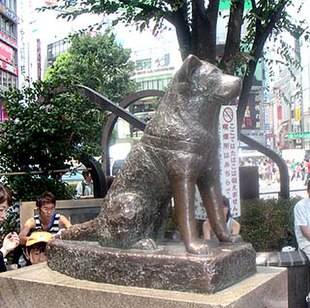Bfgrn
Gold Member
- Apr 4, 2009
- 16,829
- 2,492
- 245
The Story of Hachikō (ハチ公?, November 10, 1923March 8, 1935
Hachikō was an Akita dog..

In 1924, Hachikō was brought to Tokyo by his owner, Hidesaburō Ueno, a professor in the agriculture department at the University of Tokyo. During his owner's life Hachikō saw him off from the front door and greeted him at the end of the day at the nearby Shibuya Station. The pair continued their daily routine until May 1925, when Professor Ueno did not return on the usual train one evening. The professor had suffered a stroke at the university that day. He died and never returned to the train station where his friend was waiting.
Hachikō was given away after his master's death, but he routinely escaped, showing up again and again at his old home. Eventually, Hachikō apparently realized that Professor Ueno no longer lived at the house. So he went to look for his master at the train station where he had accompanied him so many times before. Each day, Hachikō waited for Professor Ueno to return. And each day he did not see his friend among the commuters at the station.
The permanent fixture at the train station that was Hachikō attracted the attention of other commuters. Many of the people who frequented the Shibuya train station had seen Hachikō and Professor Ueno together each day. They brought Hachikō treats and food to nourish him during his wait.
This continued for 10 years, with Hachikō appearing only in the evening time, precisely when the train was due at the station.
wiki
[ame=http://www.youtube.com/watch?v=P3s11acb7Z8]YouTube - Hachiko monogatari - Bittersweet (Akita dog)[/ame]
Hachikō was an Akita dog..

In 1924, Hachikō was brought to Tokyo by his owner, Hidesaburō Ueno, a professor in the agriculture department at the University of Tokyo. During his owner's life Hachikō saw him off from the front door and greeted him at the end of the day at the nearby Shibuya Station. The pair continued their daily routine until May 1925, when Professor Ueno did not return on the usual train one evening. The professor had suffered a stroke at the university that day. He died and never returned to the train station where his friend was waiting.
Hachikō was given away after his master's death, but he routinely escaped, showing up again and again at his old home. Eventually, Hachikō apparently realized that Professor Ueno no longer lived at the house. So he went to look for his master at the train station where he had accompanied him so many times before. Each day, Hachikō waited for Professor Ueno to return. And each day he did not see his friend among the commuters at the station.
The permanent fixture at the train station that was Hachikō attracted the attention of other commuters. Many of the people who frequented the Shibuya train station had seen Hachikō and Professor Ueno together each day. They brought Hachikō treats and food to nourish him during his wait.
This continued for 10 years, with Hachikō appearing only in the evening time, precisely when the train was due at the station.
wiki
[ame=http://www.youtube.com/watch?v=P3s11acb7Z8]YouTube - Hachiko monogatari - Bittersweet (Akita dog)[/ame]



